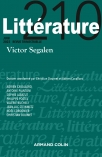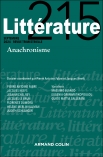
Littérature nº 171 (3/2013)
Pour acheter ce numéro, contactez-nous
Recevez les numéros de l'année en cours et accédez à l'intégralité des articles en ligne.
Les écrits esthétiques de Denis Diderot contiennent une théorie plutôt implicite du portrait (verbal comme pictural). Juxtaposer celle-ci aux usages du portrait auxquels se livre le peintre Jean-Honoré Fragonard, permet de comprendre le roman de Diderot chez qui les esthétiques scripturaire et visuelle sont inextricablement liées. Nous proposons une telle comparaison en nous concentrant sur la présence de l’esquisse dans l’art chez ces deux grands créateurs du Siècle des Lumières ainsi qu’en soulignant le rôle du temps dans leurs pratiques respectives.
The aesthetic writings of Denis Diderot contain an implicit theory of the portrait (not only verbal portraits, but visual ones as well). By placing this theory side-by-side with the uses of portraiture employed by the painter Jean-Honoré Fragonard within his art, one arrives at an indispensable tool for understanding Diderot’s conception of the novel, especially since for Diderot visual and verbal aesthetics are inextricably intertwined. In this article we pursue a comparison of Diderot’s and Fragonard’s respective ideas of portraiture ; therein we place particular emphasis on the uses of sketches and on the notions of time that appear in the work of these two creative minds from the Enlightenment.

